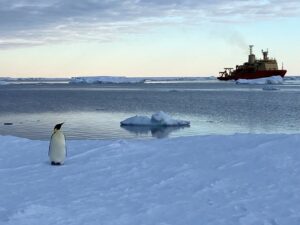
This winter a team for researchers from Moss Landing Marine Laboratories headed south to waters north of Marie Byrd Land to investigate the ecology and habitat preference of Ross Sea emperor penguins after the molt and through early reproduction, an important phase of the annual cycle that we know little about.
The remarkable winter incubation behavior of male emperor penguins and their vulnerability to the elements of the extreme Antarctic winter has captured the fascination of both researchers and the public, resulting in award winning documentaries as far back as the 1960’s. However, there is more to the emperor penguin’s annual cycle than the winter incubation; their at-sea foraging and molt migration is more dangerous to both sexes than the winter breeding. With the development of satellite tags and time-depth recorders, researchers have started to unravel the mystery of their at-sea behavior while hunting for food to nurture chicks. However, many questions remain regarding the most enigmatic side of the annual cycle, the molt migration, which consists of approximately one month at sea, one month molting, and three months at sea before returning to the colony. During the molt migration, penguins travel 100’s of kilometers to stable pack or fast ice, while building up energy stores necessary to undergo the molt and reproductive fasts.
The molt is a vulnerable and energetically demanding time for emperor penguins. The birds must remain out of the water for approximately one month while their plumage undergoes a complete replacement. During this transitional state the feathers are not waterproof and entering the water pre-maturely may cause extensive heat loss, possibly leading to hypothermia and death. Therefore, penguins must select ice floes or stable fast ice that will remain intact through the molt. Additionally, because birds at the end of the molt are in their poorest annual condition, abundant and accessible food near the molt location is required for survival.
 Molting locations are known for less than 10% of all emperor penguin colonies and due to the remoteness of the molt locations, even less is known about the post-molt migration. During this two-three month migration the birds must recover from their poorest body condition (up to 50% protein loss) and store enough energy to successfully complete the courtship fast and reproduce in April and May. Considering the value of emperor penguins as an indicator species of climate change, and the predicted changes in pack ice extent and prey distribution, it is essential that we travel to one of the most remote parts of Antarctica to study the post-molt behavior of one of the largest concentration of emperor penguins.
Molting locations are known for less than 10% of all emperor penguin colonies and due to the remoteness of the molt locations, even less is known about the post-molt migration. During this two-three month migration the birds must recover from their poorest body condition (up to 50% protein loss) and store enough energy to successfully complete the courtship fast and reproduce in April and May. Considering the value of emperor penguins as an indicator species of climate change, and the predicted changes in pack ice extent and prey distribution, it is essential that we travel to one of the most remote parts of Antarctica to study the post-molt behavior of one of the largest concentration of emperor penguins.
Funding: NSF CAREER Award to Birgitte McDonald (# 1943550)
ACA permit #: 2023-003

